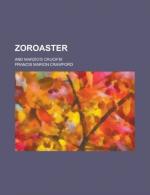It made a strong impression upon him, this thing of his own hands, and again he remained a long time resting his chin upon his folded fingers and gazing up at the drooping lids. The shadows lay softly on the modelled silver, so softly that the metal itself seemed to tremble and move, and in his reverie Marzio could almost have expected the divine eyes to open and look into his face. And gradually the shadows deepened more and more, and gathered into gloom till in the dark the black arms of the cross scarcely stood out from the darkness, and in the last lingering twilight he could see only the clear outline of the white head and outstretched hands, that seemed to emit a soft radiance gathered from the brightness of the departed day.
Marzio struck a match and lit his lamp. His thoughts were so wholly absorbed that he had not remembered the workmen, nor wondered why they had not come back. After all, most of them lived in the direction of the church, and if they had finished their work late they would very probably go home without returning to the shop. The chiseller wrapped the crucifix in the old white cloth, and laid it in its plain wooden box, but he did not screw the cover down, merely putting it on loosely so that it could be removed in a moment. He laid his tools in order, mechanically, as he did every evening, and then he extinguished the light and made his way to the door, carrying the box under his arm.
The boy who alone had remained at work had lighted a tallow candle, and was sitting dangling his heels from his stool as Marzio came out.
“Still here!” exclaimed the artist.
“Eh! You did not tell me to go,” answered the lad.
Marzio locked the heavy outer door and crossed over to his house, while the boy went whistling down the street in the dusk. Slowly the artist mounted the stairs, pondering, as he went, on the many emotions of the day, and at last repeating his conclusion, that he was glad that he had not killed Paolo.
By a change of feeling which he did not wholly realise, he felt for the first time in many years that he would be glad to see his brother alive and well. He had that day so often fancied him dead, lying on the floor of the workshop, or buried in a dark corner of the cellar, that the idea of meeting him, calm and well as ever, had something refreshing in it. It was like the waking from a hideous dream of evil to find that the harm is still undone, to experience that sense of unutterable relief which every one knows when the dawn suddenly touches the outlines of familiar objects in the room, and dispels in an instant the visions of the night.




